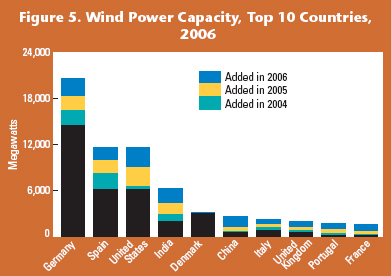Thomas explained the difference between science and the sort of pseudoscience frequently debunked by the group this way:
Science, he said, looks at all of the available evidence and tries to come up with some sort of overarching explanation that explains it all. Scientists call them “theories,” but when they use the word, they mean a well-established idea: the theory of relativity, the theory of quantum mechanics, the theory of continental drift, the theory of evolution.
Pseudoscience does the opposite.
“They start out with a belief and then they cherry-pick the data to find little nuggets that support that belief,” he said.
Daybook
- cycling: Been sick for a week, happy just to get on the bike for 40 minutes this morning.
- paper of the day: Barnes and Roy quantify the radiative forcing due to land use changes in the United States
- reading: Jeffrey Sachs’ The End of Poverty
- factoid of the day: The average resident of Chad uses 11 kwh of electricity per year
Stuff I Wrote Elsewhere
Who’s Got the Greenest Electricity Supply of Them All?

Source: The Economist
update: In response to Eli’s question regarding wind power in Denmark:
Source: Renewable Energy Policy Network
Media Sucks: Episode CVII
Rich Sweeney wonders why you hear so damn much about gasoline prices rather than the cost of food:
[W]hy is that I can’t turn on the news without hearing, invariably in very tragic terms, about soaring gasoline prices, yet there is almost no coverage of soaring food prices?
The short answer is that the media sucks. Seriously. We’re just as short-sighted and inattentive as most folk. And in this case, the price of gasoline is obvious and easily quantified. It’s in giant letters on every single Kwik-E-Mart on every corner in town – exactly the same units of measure, easily compared from one store to the next and one day to the next. So we notice the price of gasoline. The price of a loaf of bread? Not so obvious. Not printed on giant signs on every street corner. Not quite so easily and obviously comparable from one store to the next.
We in the media are just like other ordinary folk who think about that which is the most noticeable, rather than that which is the most important.
Potato photography
Solar Tax Credits
 My colleague Michael Coleman had an excellent piece in this morning’s paper laying out the stakes and contending factions in the fight over solar tax credits:
My colleague Michael Coleman had an excellent piece in this morning’s paper laying out the stakes and contending factions in the fight over solar tax credits:
Senate Republicans and Democrats, almost all of whom say they support extending the solar tax credit, haven’t been able to agree on how to pay for it.
Most Democrats, including Bingaman, contend that Congress should rescind $18 billion in annual federal subsidies given to the biggest oil and gas companies since 2006 and redirect them to the solar industry.
“This is not a tax benefit they had before— they were doing fine before and they are doing fine now,” Bingaman said, referring to record profit margins that oil and gas companies have posted in recent years. “I don’t think this is a major setback for oil and gas companies given the profits they have had.”
The U.S. House approved the tax shift in February.
But Sen. Pete Domenici of New Mexico, the top Republican on the Senate energy committee, said he won’t support it.
Domenici, who is retiring from Congress after his term ends in January, said the solar tax credit extension doesn’t need to be paid for.
“We know it will work and will yield benefits to the American economy, so I would vote for it without the offsets,” Domenici said, referring to proposals to “offset” the breaks given to solar companies by eliminating some tax breaks for oil companies.
“I think they’re so important they should be adopted without offsets,” Domenici said.
(image courtesy National Solar Observatory)
The Dramatic Effect of Europe’s Kyoto Commitment
More evidence that getting this whole climate mitigation thing right is going to be hard:
Early analysis of data out today from the European Commission shows that emissions rose about 1.1% last year to 1.9 billion metric tons. That’s after similar increases in 2005 and 2006.
Weitzman pt. II
That’s all well and good, Marty, but stop squirming and tell us how much you’d price carbon at? That’s all we really care about:
Weitzman hemmed and hawed and noted that the whole point of his paper was that there are these big uncertainties, and that previous attempts to calculate the socially optimal price on carbon haven’t accounted for these and thus are wrong, and that you couldn’t even really do the calculation with the current tools we have. But he finally acknowledged that if you made him philosopher-king and demanded an answer he would say that the price on emissions (i.e. a carbon tax or the price of a cap-and-trade permit) should be $50 per ton of CO2, rising at rate of a few percent over inflation.
How Stuff Works
I’m a big fan of what I call “how stuff works” journalism: take a topic of the day and step back and explain how the darn thing works. Too often, we write either incrementally, or for insiders who already know the underlying structure of what we’re talking about. (This explains, for example, my ultimately fruitless search, recently for a story explaining what Bear Stearns did for a living.)
My colleague Andrew Webb turned a nice piece this morning about how our gasoline gets here. The news peg was a mixup that put diesel in people’s regular gasoline tanks. But you don’t even need that for this to be a fun and useful story of pigs and water and society’s plumbing.


